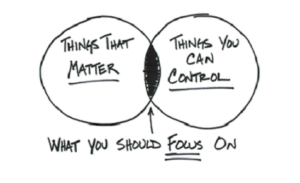Lights, Action…Camera!

Managing anxiety: how to park your “unmanageables”.
In recent leadership commentary and professional newsfeeds, we see both confident outreach and anxious vulnerability.
In some cases, such as Airbnb CEO Brian Chesky’s public letter on changes to his company, business-facts transparency weighs against raw emotion: “What we are about is belonging…I am truly sorry. Please know this is not your fault”.
In others, leaders celebrate achievement and unexpected successes…while at the same time questioning whether such things are sustainable or even repeatable.
Personal testimonials loom large: joys, newfound opportunities and silver linings, but also brokenness, despair and “please tell me I’m not the only one feeling like this”.
The reality is that, in some unique way, everyone is facing their own landscape of intersecting anxieties and concerns.
The question for everyone is, how to manage this?
Nobody has a perfect solution, but we can start by looking at what we can control.
And what we cannot.
Hypothetically speaking…
A recent LHH article draws on clinical psychology to simplify the “how to manage this” question.
In proposing Four Steps Leaders Can Take to Help Identify and Relieve Stress Within Their Teams, the article describes two types of anxiety.
“Although we cannot eliminate uncertainty or the anxiety it causes…everyone can take steps to manage it. One of the first steps in that process is to separate ‘hypothetical’ anxiety from ‘empirical, measurable’ anxiety.”

On one hand, there are things you can control. Think of technology platforms, processes for virtual collaboration, requirements for new planning formats or tools. Things that may make you anxious, but that can be changed through your own action.
On the other, you may worry about, say, the length of time it may take for a coronavirus vaccine to be available. A very real concern and one with massive business impact – but unless you are a clinical researcher, not one you control in any way.
This second category is hypothetical anxiety. It is the land of the “unmanageable”.
Lights off, connections on.
The authors suggest some low-tech ways to start to park your unmanageables.
The first is a commitment to take time every day, for a meaningful period, to stop the flow of crisis thinking and instead breathe in what is going on around you.
Turn off the lights – screens, devices, social, news. Think closely about what you don’t control, and park those things. Identify things you can manage, pick one, then start framing a solution that can help reduce anxiety and build confidence
In a related point, keep in mind the fact that, even though everyone has their own mix of concerns, there are many types of anxiety that are shared.
As a leader, you can watch for connections – across teams, geographies, mutual interests, family or other responsibilities – and help build peer or community networks that can defuse shared anxieties. Think outside the org chart!
Roll camera.
Clinical psychology might feel abstract, but this point is entirely tactical. To help build awareness and engagement in a virtual world, turn your camera on!
And not just your own camera – where possible, encourage all participants in virtual meetings to turn theirs on as well.
If we don’t have visual cues, we can’t connect as well as we need to.
It’s harder to know when the ‘unmanageables” have become too heavy to carry, and harder to know how someone is doing.
A friendly face can make all the difference.
Cue the coach.
As leadership coaches, we see the impact of anxiety and the weight that lifts by managing it.
We know that you don’t need our help to turn on your computer camera; to be visible and present and aware of the stresses felt by those around you.
But what about your internal “camera”? Is it always crystal-clear when something is controllable and when it isn’t? Give us a call, and we can help you draw the lines.
The work of a coach can be about driving ahead and finding ways forward. But sometimes, it’s also about helping you build a parking lot.
